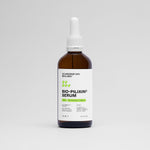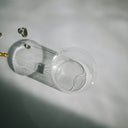Understanding new hair growth can be an essential aspect of hair care and maintenance, especially for those experiencing hair loss or seeking to improve their hair’s health. With a variety of factors influencing hair growth, recognizing what new hair growth looks like can help individuals monitor their progress and make informed decisions about their hair care routines.
Table of content
What does new hair growth look like?
New hair growth typically presents itself as fine, soft strands that may initially appear shorter and less pigmented than existing hair. These tiny hairs, often referred to as "baby hairs," can vary in texture and color but generally have a lighter appearance. New hair growth can be observed in various areas of the scalp, but it is most noticeable along the hairline, part lines, or areas where hair thinning has occurred.
In terms of texture, new hair growth is often finer and softer than mature hair. It might feel different to the touch and can sometimes be more susceptible to breakage. This new growth phase usually indicates that hair follicles are active and healthy, signaling a positive response to treatments or lifestyle changes aimed at promoting hair growth.
As your leading source for hair health information over the past 4 years, we never compromise on accuracy. When it comes to your health, you deserve information you can truly rely on - and earning your trust is our top priority.
Here's how Scandinavian Biolabs ensures every piece of content meets the highest standards of accuracy and integrity:
- Credentialed Experts: Our reviewers are actively practicing doctors and medical researchers
- Stringent Reviews: Content undergoes rigorous editing by subject specialists and review by a practicing doctor.
- Evidence-Based: We rely on well-established research from trusted scientific sources like peer-reviewed journals and health authorities.
- Full Transparency: Our editorial standards, writer credentials, reviewer credentials, correction process, and funding are all publicly documented.
- Independent Voice: While we do promote products, we operate in a vacuum to business operations. Our main goal is just an unwavering commitment to providing medically-sound guidance.
You can count on Scandinavian Biolabs to consistently deliver the trustworthy health information you deserve. Read our Editorial Standards.
Signs of New Hair Growth
When monitoring for new hair growth, several signs can help you identify the early stages:
- Soft, Fine Strands: New hair often feels much softer than existing hair and may have a fine texture.
- Short Length: New growth typically appears shorter than the surrounding hair, sometimes only a few millimeters long.
- Change in Color: It may show a lighter color or different pigmentation compared to the rest of your hair.
- Increased Volume: You may notice an overall increase in volume as these new hairs emerge and fill in thinning areas.
How Long Does It Take for New Hair to Grow?
Hair grows at an average rate of about half an inch per month, which translates to approximately six inches per year. However, the visibility of new hair growth can depend on several factors including genetics, diet, and overall health. Typically, visible new hair growth may take anywhere from a few weeks to several months to become noticeable, especially if you are focusing on improving the health of your hair through various treatments or changes in your lifestyle.
Factors Affecting New Hair Growth
Several factors can influence the rate and appearance of new hair growth:
- Genetics: Your genetic background plays a significant role in hair growth patterns, thickness, and overall health.
- Diet: A balanced diet rich in vitamins and minerals, particularly biotin, zinc, and omega-3 fatty acids, can promote healthy hair growth.
- Hormonal Changes: Hormonal fluctuations due to pregnancy, menopause, or medical conditions can significantly affect hair growth.
- Hair Care Practices: Using harsh chemicals, excessive heat styling, or infrequent trims can hinder the growth of healthy new hair.
How to Encourage New Hair Growth
If you're looking to promote new hair growth, consider the following tips:
- Maintain a Healthy Diet: Include foods rich in vitamins and minerals essential for hair health. Leafy greens, nuts, fish, and eggs are excellent options.
- Stay Hydrated: Drinking enough water helps maintain overall body health, including your hair.
- Scalp Massages: Regular scalp massages can increase blood circulation to the hair follicles, promoting growth.
- Limit Heat and Chemical Treatments: Reducing the use of heat styling tools and chemical treatments can help minimize damage to your hair.
Conclusion
Recognizing what new hair growth looks like can empower individuals to take better care of their hair and understand their growth patterns. By identifying the signs of new growth and implementing strategies to promote healthy hair, you can achieve a fuller, more vibrant head of hair over time. Monitoring your hair's progress and making informed decisions based on your observations can lead to better hair health and improved overall confidence.
Tired of Thinning Hair? Try a Clinically Tested Serum.
Looking for a natural way to regrow hair and achieve a thicker, fuller head of hair? Ditch the stinging nettle for hair loss – Bio-Pilixin Serum is a drug-free hair activation serum that delivers clinically tested results.
Here's why Bio-Pilixin is superior:
- Clinically Tested Results: 93% of users saw a reduction in hair loss, and 73% experienced increased hair density.
- Safe and Natural: Unlike harsh chemicals, Bio-Pilixin uses plant growth factors derived from stem cell technology to nourish hair follicles and stimulate growth.
- Fast-Acting: See visible results in as little as 45 days (most typically see results within 150 days).
Stop wasting time on unproven remedies. Bio-Pilixin is the safe, natural serum you've been searching for.
Read more:






